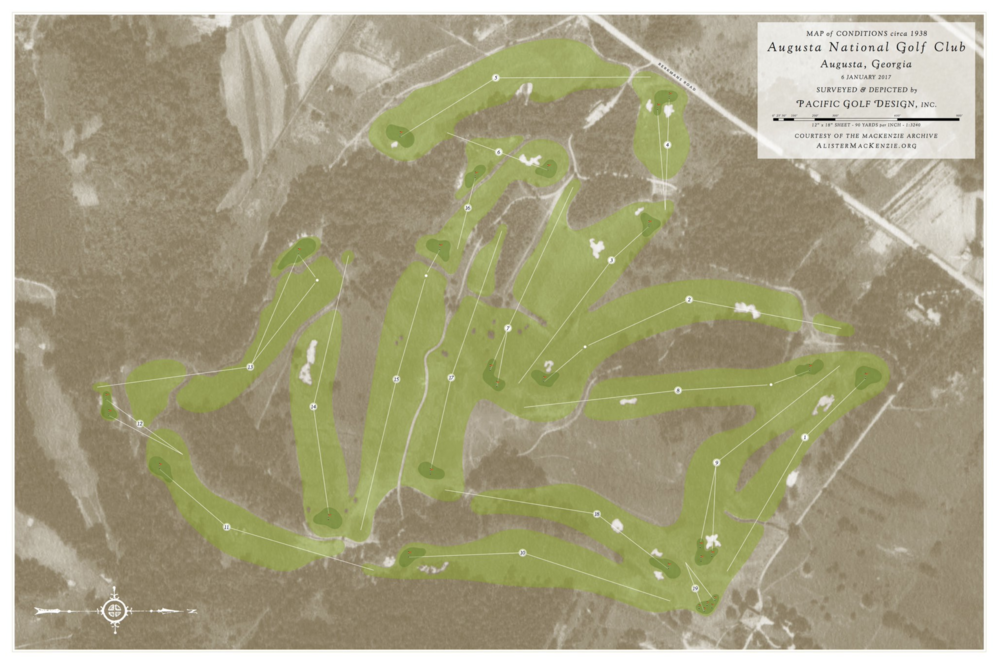How Augusta National Has Evolved
Reviewing 21st-century changes at the home of the Masters


I love Augusta National and the Masters. The course is home to several of the greatest holes in golf, and it’s hard to imagine a better inland property for the championship game. The rolling hills provide the kind of challenge that can’t be diminished by advances in equipment technology.
For the design of Augusta National in 1931, Bobby Jones and Clifford Roberts commissioned the great Dr. Alister MacKenzie, who was coming off his triumphs at Cypress Point and Pasatiempo in Northern California. The “Good Doctor” had thoroughly established himself as one of the top golf course architects in the world. He was known for the artistic flair of his bunker and green designs, and for creating courses that could test the world’s best players while remaining playable for the average Joe. He and Bobby Jones would work together on the new design in Georgia.

A 1933 aerial photograph of Augusta National
MacKenzie and Jones’s conscious inspiration for Augusta National was the Old Course at St. Andrews, which they revered. Their goal was to create an inland links that embodied the Old Course’s strategic principles. MacKenzie and Jones wanted players not only to execute shots but also to make nuanced risk-reward decisions.
Like the Old Course at St. Andrews, the original Augusta National had wide fairways and threatening hazards placed exactly where good players might want to hit their shots. Unlike the Old Course, MacKenzie and Jones’s design had strikingly few bunkers—only 22 at first. So the essence of Augusta National’s challenge came from its brilliant, severely contoured greens and surrounds. A bogey golfer could negotiate these green complexes without too much pain, but an expert player, in order to make birdies, needed to hit precise shots from advantageous angles.
As Bobby Jones put it in his book Golf Is My Game, “We want to make bogeys easy if frankly sought, pars readily obtainable by standard good play, and birdies—except on par 5s—dearly bought.”
When it opened in 1933, Augusta National was one of the best courses in the world. Today, it’s still great. Sadly, though, in the early 2000s, the club attempted to toughen (or “Tiger-proof”) the course and, in the process, made it worse. Specifically, rampant tree planting has cost Augusta National some of its MacKenzie-and-Jones spirit—a spirit that established the reputation of the Masters and produced many of the most memorable tournaments in golf history.

The original design of Augusta National. Credit: @DoctorMacKenzie
Augusta National and the Masters through the years
The Masters may be the greatest event in sports. The tournament has bolstered the legends of Arnold Palmer, Jack Nicklaus, Seve Ballesteros, and Tiger Woods, but the course is still the star of the show. Plain and simple, Augusta National is why the Masters is the Masters. Immortality hangs on every shot, and every contender is constantly aware of the razor-thin margin between “all-time great” and “epic disaster.” Great shots produce pivotal birdies; mediocre shots yield tough two-putts and impossible up-and-downs. “Every shot is within a fraction of disaster,” Gary Player once said. “That’s what makes it so great.”
When Player won his three green jackets, Augusta National still had roomy fairways and essentially no rough. The course rewarded a cerebral approach: you won by setting up good angles to attack flags placed on the precarious shelves, knobs, and corners of the intricate greens. Every yard away from the preferred line produced worse angles and tougher shots. Still, those who found the fairway but not the ideal spot could recover with an extraordinary shot. If they couldn’t pull it off, their struggles were compounded.
Wide fairways, therefore, are part and parcel of Augusta National’s brilliance. They allow all golfers, from high handicappers to Rory McIlroy, to find their own ways to success—or, as the case may be, their own ways to disaster. Geoff Ogilvy, a golf course architect as well as a major champion, said it particularly well in an interview with the Augusta Chronicle: “Nearly every time you hit it to the wrong side of the green or the wrong side of the fairway you have no chance, but you are given a lot of space to find out for yourself.”
Today, however, what Ogilvy describes here is becoming less and less the reality. Seemingly every year, new trees appear along the sides of Augusta National’s fairways. In an effort to control scoring, the club is slowly strangling its course.
How we got here
The distance explosion in golf, powered by the advent of the modern solid-core ball and the large-headed metal driver, prompted Augusta National to tinker. The club has lengthened holes, introduced a “second cut” (that is, rough), and tightened playing corridors with tree plantings. The latter two changes in particular have altered the ethos of the course. Augusta National is becoming less a test of strategy and more a test of survival, akin to a U.S. Open venue.
If that sounds like an extreme claim, keep in mind that Tiger Woods said essentially the same thing in his book The 1997 Masters: My Story: “It wasn’t as easy to understand why Augusta felt it should change the nature of the course in other ways, such as adding rough —that ‘second cut.’ It also added trees, which narrowed the corridors of play and eroded strategic values that Bobby Jones and Alister MacKenzie had created as the course’s essential feature.”
Granted, it’s understandable that ANGC would lengthen the course. Can you imagine what today’s pros would do to the 15th hole if it played to 485 yards, as it did at the 1934 Masters?
But the narrowing of Augusta National has been a tragedy. The extra trees and rough have made the Masters a less interesting and less thought-provoking challenging. The changes have limited the field’s ability to use a variety of angles to attack the course. Tight courses tend to encourage a mindless, robotic style of golf, one where players are told where to hit each shot instead of being asked to use imagination and strategic acumen.
For an example of the unfortunate evolution of Augusta National’s design, look no further than the beginning of Amen Corner, the long par-4 11th hole.
No. 11 – White Dogwood – Par 4, 505 yards
The 11th hole has undergone a series of changes since Tiger Woods won the 1997 Masters. Some of these changes have been good; others have stripped away the hole’s intended strategy.

Scoring differential to par on the 11th hole at Augusta National since 1983. Credit: Data Golf
As you can see, in the mid-90s, scoring on the 11th hole plunged. Metal driver heads and new-age balls like the Titleist Professional and the Top-Flite Strata took the bite out of the hole. By 1997, Tiger Woods was bombing it down the right and leaving himself wedges in.
And so in 1999, Augusta National moved the tee box to the right in order to limit access to the right side of the fairway. The scoring average jumped back to historic norms, and the hole retained much of its strategic identity: the right side of the fairway, which offered the best angle to certain pins, was still available, if harder to access.
In 2002, the year after the Titleist Pro V1 made its Masters debut, the club enlisted Tom Fazio to lengthen the 11th hole, making it a whopping 490 yards while maintaining its width. If the goal was bump scoring back up, mission accomplished.
Dramatic as they were, these alterations in 1999 and 2002 did not fundamentally alter MacKenzie and Jones’s original design. The options to go right or left off the 11th tee based on the day’s pin position remained intact. But in 2004, ANGC chairman Hootie Johnson commissioned a major tree planting up the right side of the hole. The new trees choked No. 11’s corridor, shrinking it from 90 to 45 yards.
This is when the character of the hole truly shifted. Since 2004, the 11th has been harder than ever, but its strategy has been compromised. Players are forced to approach every pin on the difficult green from what used to be the left half of the fairway.

The 11th hole at Augusta National since 1999
Today, with the hole playing over 500 yards, some players don’t even try to hit the green with their second shot. Fearing a bad bounce from the mounds around the green, they choose to lay up short right and chip on for the par or bogey. In this way, No. 11 at Augusta National has more a slog than an exciting arena of both opportunity and danger.

The scoring trends on the par-4 11th hole at Augusta National. Credit: Data Golf
The above trends tell the story of No. 11’s modern evolution. In the mid-80s and early 90s, the field made birdie or better about 10% of the time. Today, that rate has declined to less than 5%. At the same time, the double-bogey-or-worse rate has gone from about 4% to about 6% in the same period. Effectively, with its tree-planting efforts on the 11th hole, Augusta National has traded birdies for bogeys and doubles.
No. 10 – Camelia – Par 4, 495 yards
In contrast, the 10th hole at Augusta National has seen far fewer changes in recent decades. Yes, it was drastically altered in 1937, when Perry Maxwell relocated the green from a bowl to the right of the famous MacKenzie bunker to its current location on a plateau. Since then, however, No. 10 has remained more or less the same.

The 10th hole at Augusta National in 1999 (bottom) vs. today (top)
In 2001, the club added 10 yards to the hole and introduced the “second cut.” While the rough narrowed the fairway somewhat, the playing corridor stayed wide. It may surprise some people, then, that scoring patterns on the 10th hole have been steady since 1983, despite equipment advances.

Scoring on Augusta National's 10th hole. Credit: Data Golf
Basically, the hole plays as it did after Maxwell made the changes: it’s a long, stern par 4 that yields birdies only to great shots.
The stability of No. 10’s identity over the years raises the question of how the 11th hole would have fared if it had simply been lengthened. Would it have retained the strategy that made it one of the finest par 4s in all of golf?
No. 17 – Nandina – Par 4, 440 yards
In the 80s and 90s, Masters competitors made birdies and bogeys on the 17th hole roughly 30% of the time, with the distribution skewing slightly toward bogeys. Today, we see 20% bogeys and less than 10% birdies.

Historical scoring patterns on the 17th hole at Augusta National. Credit: Data Golf
Why did this happen? Surprise, surprise: in the early 2000s, the club planted a veritable forest on No. 17, closing 0ff the original shared fairway with the 15th hole. So what used to be a dynamic juncture in Augusta National’s closing stretch, one where you almost expected two-shot swings, is now a par 4 where players are content to make a 4.

The changes to the 17th hole at Augusta National and their impact on playing options
If Jack Nicklaus had faced today’s version of No. 17 in 1986, his tee shot would have found a grove of trees. He likely would not have been able to hit the green and set himself up for one of the greatest moments in Masters history.
https://youtu.be/6X9-LRZNM60
No. 9 – Carolina Cherry – Par 4, 460 yards
The closing hole on Augusta National’s front nine has seen relatively minimal changes over the past 50 years, aside from the introduction of rough and a 20-yard lengthening in 2011. Again, this is the recipe the club should use on every hole. Like No. 10’s, No. 9’s scoring trends have been flat since 1983.

Birdies, pars, bogeys, and "others" on the 9th hole at Augusta National. Credit: Data Golf
On the 9th hole at Augusta National, success comes not from distance off the tee but from a precise approach and a steady hand with the flatstick on the incredibly severe green. Great shots are rewarded with birdies, poor shots penalized by bogeys. The hole hasn’t been monkeyed with recently, and lo and behold, it still works.
◊
Let me be clear. Despite the tree plantings, despite the “second cut,” and despite all of my critiques, I still love the Masters. Year in and year out, Augusta National puts on a compelling show. But I would argue that it’s less compelling than it could be. If the club were to restore the width and strategy to the holes it has altered most, we would see more spectacular shots, more near misses, and a more exciting tournament.
Obviously ANGC will need to keep responding to distance gains, as elite golfers aren’t going to be hitting it shorter anytime soon. Right now, even, there are plans to add length to the 5th and 13th holes. But I hope the club has learned from the durability of the 9th and 10th holes, and that future lengthening isn’t coupled with narrowing. This isn’t the PGA Championship or the U.S. Open; it’s the Masters, and it should be infused with the spirit of Alister MacKenzie and Bobby Jones’s tribute to the roots of the game.
Augusta National is still great, but it’s not what it should be: the best.
More Masters coverage from The Fried Egg team:
Is Augusta National Turning Over a New Leaf?
Geoff Ogilvy’s notes on all 18 at Augusta National
Stories worth your time and tracking at the 2022 Masters
The Art Behind Augusta’s Roars: Focal points in Alister MacKenzie’s routings
Tiger’s Masters flirtation is something more than ceremonial
Leave a comment or start a discussion
Engage in our content with thousands of other Fried Egg Golf Club Members
Engage in our content with thousands of other Fried Egg Golf Members
Get full access to exclusive benefits from Fried Egg Golf
- Member-only content
- Community discussions forums
- Member-only experiences and early access to events











Leave a comment or start a discussion
Lorem ipsum dolor sit amet, consectetur adipiscing elit. Suspendisse varius enim in eros elementum tristique. Duis cursus, mi quis viverra ornare, eros dolor interdum nulla, ut commodo diam libero vitae erat. Aenean faucibus nibh et justo cursus id rutrum lorem imperdiet. Nunc ut sem vitae risus tristique posuere. uis cursus, mi quis viverra ornare, eros dolor interdum nulla, ut commodo diam libero vitae erat. Aenean faucibus nibh et justo cursus id rutrum lorem imperdiet. Nunc ut sem vitae risus tristique posuere.